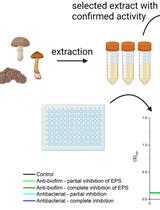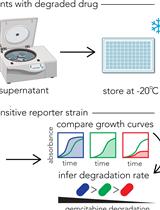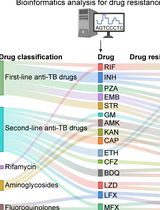- Submit a Protocol
- Receive Our Alerts
- Log in
- /
- Sign up
- My Bio Page
- Edit My Profile
- Change Password
- Log Out
- EN
- EN - English
- CN - 中文
- Protocols
- Articles and Issues
- For Authors
- About
- Become a Reviewer
- EN - English
- CN - 中文
- Home
- Protocols
- Articles and Issues
- For Authors
- About
- Become a Reviewer
Minimal Inhibitory Concentration (MIC) Assay for Acinetobacter baumannii
Published: Vol 4, Iss 23, Dec 5, 2014 DOI: 10.21769/BioProtoc.1308 Views: 48605
Reviewed by: Arsalan DaudiKanika GeraAnonymous reviewer(s)

Protocol Collections
Comprehensive collections of detailed, peer-reviewed protocols focusing on specific topics
Related protocols

SIMBA Method—Simultaneous Detection of Antimicrobial and Anti-biofilm Activity of New Compounds Using Salmonella Infantis
Meta Sterniša [...] Anja Klančnik
Aug 5, 2023 1877 Views

Functional Assay for Measuring Bacterial Degradation of Gemcitabine Chemotherapy
Serkan Sayin and Amir Mitchell
Sep 5, 2023 1644 Views

Identification of Mycobacterium tuberculosis and its Drug Resistance by Targeted Nanopore Sequencing Technology
Chen Tang [...] Guangxin Xiang
Feb 5, 2025 1873 Views
Abstract
Minimal inhibition concentration (MIC) is the lowest concentration of an antimicrobial agent that can inhibit the visible growth of a microorganism after overnight incubation. MIC determination is used as not only a diagnostic tool in treating bacterial infections for clinicians but also a research method in evaluating the efficacy of an antimicrobial. Multidrug resistance Acinetobacter baumannii (A. baumannii) has emerged in recent years. Accurate determination of resistance by MIC assay is important in coping with this superbug. Here we described a protocol for determining MIC for A. baumannii in hope of assisting researchers and physicians in confirming resistance of clinical isolates correctly.
Keywords: Acinetobacter baumanniiMaterials and Reagents
- A. baumannii (ATCC, catalog number: 17978 )
- Escherichia coli (E. coli) (ATCC, catalog number: 25922 )
- Mueller Hinton broth (Sigma-Aldrich, catalog number: 70192 )
- Tigecycline (Wyeth, catalog number. 0220620-09-7 )
- NaCl (MDBio, catalog number: 101-1647-14-5 )
- KCl (Sigma-Aldrich, catalog number: P1147 )
- Na2HPO4 (J.T.Baker®, catalog number: 3828-01 )
- KH2PO4 (J.T.Baker®, catalog number: 4921-07 )
- HCl (J.T.Baker®, catalog number: 9535-03 )
- Tryptone (Pronadisa, catalog number: 1612 )
- Yeast extract (Pronadisa, catalog number: 1702 )
- Cation-adjusted Mueller-Hinton broth (CAMHB) (see Recipes)
- PBS (1 L) (see Recipes)
- Lysogeny broth (LB) (see Recipes)
Equipment
- 50 ml polystyrene culture tubes (sterile)
- Spectrophotometer to measure absorbance of cell culture (OD600)
- 37 °C shaking and static incubators
- Multichannel pipette (volume ranges 10 μl-1,000 μl)
- 1.5 ml Eppendorf tube
- A centrifuge machine
- 1 ml cuvette
Procedure
- Preparation of antibiotic stock solution and dilution range
- Obtain antibiotic powder from the pharmaceutical company and make a note of the relevant information, including expiry date, potency, stability and solubility.
- Prepare 1 ml 10 mg/ml tigecycline stock solution.
- Choose a suitable range of antibiotic concentrations to be tested for A. baumannii if available. If the range is not available, maximal concentration 512 µg/ml and serial diluted concentrations with CAMHB solution are used. The lowest dilution concentration is depended on the possible minimal inhibition concentration. 0.125 µg/ml is the lowest possible dilution concentration.
- To get different tested concentrations, solution of 10-time maximal concentration is prepared by dispensing the appropriate amount of stock solutions with micropipette and diluting with CAMHB solution.
For example, to get 1 ml 5,120 µg/ml solution, dispense 0.512 ml stock solution and dilute with 0.488 ml CAMHB solution.
- Obtain antibiotic powder from the pharmaceutical company and make a note of the relevant information, including expiry date, potency, stability and solubility.
- Preparation of inoculum
- Dissolve a single colony of A. baumannii, which is picked from a LB streak plate, in 3 ml LB broth and incubate overnight at 37 °C, 220 rpm.
- Check OD600 (1 OD600= 109 CFU/ml) with a spectrophotometer.
- Dilute the bacterial solution with LB broth to get 0.1 OD600 suspension and incubate at 37 °C, 220 rpm till mid-log phase (~2 h).
- Put 1 ml mid-log phase bacterial solution in 1.5 ml Eppendorf tube, centrifuge at 6,000 rpm for five min, and wash with 1 ml PBS solution. Repeat the washing procedure twice.
- Dissolve the bacterial pellet with 1 ml CAMHB solution.
- Get 100 µl the above bacterial solution and mix it with 900 µl PBS, then check OD600 with a spectrophotometer. The bacterial concentration can be deduced from the measured value x 10.
- Adjust the bacterial concentration to 1 x 107 CFU/ml with CAMHB solution (1 OD600 ~109 CFU/ml).
- Dissolve a single colony of A. baumannii, which is picked from a LB streak plate, in 3 ml LB broth and incubate overnight at 37 °C, 220 rpm.
- Inoculation and incubation
- Mix 50 µl adjusted A. baumannii bacterial solution (1x107 CFU/ml), 850 µl CAMHB and 100 µl solutions of 10-time serial tested antibiotic concentration. Use the E. coli ATCC25922 bacterial solution as a control.
- Use 900 µl CAMHB and 100 µl solutions of 10-time serial tested antibiotic concentration for OD600 measurement comparison as a negative control.
- Incubate at 37 °C, 220 rpm for 20-24 h.
- Mix 50 µl adjusted A. baumannii bacterial solution (1x107 CFU/ml), 850 µl CAMHB and 100 µl solutions of 10-time serial tested antibiotic concentration. Use the E. coli ATCC25922 bacterial solution as a control.
- Reading and interpretation
- Check OD600 with a spectrophotometer.
- Read the MIC endpoint as the lowest concentration of antibiotic at which there is no visible growth of bacteria (no solution turbidity on naked eyes), and the difference of measured and background OD600 is less than 0.01.
- Check OD600 with a spectrophotometer.
Recipes
- CAMHB
Dissolve 23 g Mueller Hinton broth in 0.9 L of distilled water
Adjust pH to 7.2 using HCl
Then fill up to 1,000 ml with distilled water
Sterilized by autoclaving at 121 °C for 15 min
And added
2 ml 10 g/L Ca2+ (8.36 g MgCl2․2H2O in 100 ml ddH2O)
1 ml 10 g/L Mg2+ (3.68 g CaCl2․6H2O in 100 ml ddH2O)
Stored at 4 °C
- PBS (1 L)
8 g NaCl
0.2 g KCl
1.44 g Na2HPO4
0.24 g KH2PO4
Dissolve in 900 ml ddH2O
Adjust pH to 7.2 using HCl
Sterilized by autoclaving at 121 °C for 15 min
- LB
10 g tryptone
5 g yeast extract
5 g NaCl
Fill to 1 L with ddH2O
Sterilized by autoclaving at 121 °C for 15 min
Acknowledgments
The development of this protocol was funded by a grant from the National Taiwan University Hospital, Chu-Tung Branch.
References
- Lin, M. F., Lin, Y. Y., Yeh, H. W. and Lan, C. Y. (2014). Role of the BaeSR two-component system in the regulation of Acinetobacter baumannii adeAB genes and its correlation with tigecycline susceptibility. BMC Microbiol 14: 119.
Article Information
Copyright
© 2014 The Authors; exclusive licensee Bio-protocol LLC.
How to cite
Lin, M., Lin, Y. and Lan, C. (2014). Minimal Inhibitory Concentration (MIC) Assay for Acinetobacter baumannii. Bio-protocol 4(23): e1308. DOI: 10.21769/BioProtoc.1308.
Category
Microbiology > Antimicrobial assay > Antibacterial assay
Cell Biology > Cell isolation and culture > Cell growth
Do you have any questions about this protocol?
Post your question to gather feedback from the community. We will also invite the authors of this article to respond.
Tips for asking effective questions
+ Description
Write a detailed description. Include all information that will help others answer your question including experimental processes, conditions, and relevant images.
Share
Bluesky
X
Copy link









